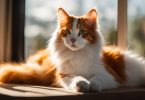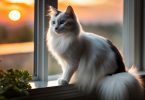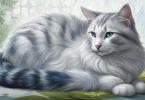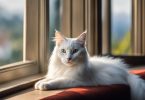Ragdoll cats are a popular breed known for their distinctly docile and friendly nature. In this article, we will explore the origins, physical characteristics, personality traits, care needs, common health issues, and tips for choosing a Ragdoll cat.
Origins of Ragdoll Cats:
Ragdoll cats have an interesting history. We will delve into their origins and learn about the breed development over the years.
Physical Characteristics of Ragdoll Cats:
Ragdolls possess unique physical attributes that set them apart. We will discuss their size, weight, coat colors, patterns, and overall body structure.
Personality Traits of Ragdoll Cats:
One of the most endearing qualities of Ragdolls is their friendly and sociable nature. We will explore their personality traits, including their gentle and relaxed demeanor, as well as their intelligence and trainability.
Caring for a Ragdoll Cat:
To keep a Ragdoll cat healthy and happy, proper care is essential. We will cover their grooming requirements, exercise and playtime needs, and provide feeding guidelines.
Common Health Issues in Ragdoll Cats:
Like any breed, Ragdolls may be prone to certain health issues. We will discuss two common conditions to be aware of: Hypertrophic Cardiomyopathy (HCM) and Polycystic Kidney Disease (PKD).
Choosing a Ragdoll Cat:
If you are considering adding a Ragdoll cat to your family, it is essential to make an informed decision. We will provide tips on finding a reputable breeder and explore adoption options for Ragdoll cats.
By understanding the origins, characteristics, care needs, health considerations, and selection process of Ragdoll cats, you will be well-equipped to provide a loving and nurturing environment for this wonderful breed.
Note: The formatting of the text may not be visible in the response as the formatting tags are not supported in plain text response.
Key takeaway:
- Ragdoll cats are friendly and sociable: Ragdoll cats have a gentle and relaxed nature, making them great companions. They enjoy spending time with their owners and are easily trainable.
- Ragdoll cats have unique physical characteristics: These cats are known for their larger size and weight. They also have a variety of coat colors and patterns, and their body structure is well-proportioned.
- Caring for a Ragdoll cat requires grooming and exercise: Ragdolls have semi-longhair coats that require regular grooming. They also have moderate exercise needs and should be provided with playtime and mental stimulation.
Origins of Ragdoll Cats
The origins of Ragdoll cats hold fascinating insights into their history and breed development. From their mysterious beginnings to the careful breeding practices that have shaped their distinct characteristics, we will dive into the captivating journey of these enchanting feline companions. Unveiling the secrets behind their creation and the pivotal moments that have shaped the Ragdoll breed, this section invites you to explore the rich heritage that has made these cats so beloved.
The History of Ragdoll Cats
The History of Ragdoll Cats dates back to the 1960s. Ann Baker, a woman from Riverside, California, developed the breed. She bred her domestic long-haired cat, Josephine, with other cats, resulting in kittens with unique characteristics. These kittens had docile temperaments and color-point patterns similar to Siamese cats.
Ann Baker believed that Josephine’s kittens had special qualities due to their lineage. She named this new breed Ragdolls because they tend to go limp when picked up. Ragdolls quickly gained popularity and were officially recognized as a breed in the 1960s. Today, they are recognized and bred worldwide.
Ragdolls have always been loved for their gentle nature and sociability. They make excellent companions and are often described as “puppy-like” in their interactions with humans. Ragdolls are also highly trainable and easily learn tricks and commands.
Understanding The History of Ragdoll Cats provides insight into their origin and development as a breed. It highlights their unique characteristics and helps explain their popularity among cat enthusiasts today.
If you are considering adding a Ragdoll cat to your family, it is important to find a reputable breeder or explore adoption options. This ensures that you get a healthy and well-cared-for Ragdoll cat while also supporting responsible breeding practices.
Breed Development
The breed development of Ragdoll cats can be traced back to Daddy Warbucks, a specific male cat. Through careful breeding and selection, Ragdoll cats were developed with distinct characteristics and temperament.
Key Players:
| – Ann Baker: Breed creator and founder of the Ragdoll cat breed |
| – Irvine Family: Helped establish and promote the Ragdoll breed |
Ann Baker started breeding cats to create a large, affectionate cat breed with unique coat patterns. She used Daddy Warbucks as the foundation of the breed, as he had the desired traits. Baker also established strict rules for breeding and licensing to preserve the breed’s integrity.
The Irvine family played a crucial role in further developing and promoting the breed. They worked closely with Ann Baker and helped establish breed standards. Their efforts led to recognition from cat associations and worldwide popularity among cat lovers.
To sustain the qualities of Ragdoll cats, finding reputable breeders who adhere to the breed standards and guidelines is essential. Potential owners should ensure that breeders have a good reputation and follow ethical practices.
When considering adopting a Ragdoll cat, potential owners should be aware of adoption options available. Shelters and rescue organizations sometimes have Ragdolls available, providing a second chance for these wonderful cats.
Physical Characteristics of Ragdoll Cats
Ragdoll cats are known for their unique physical characteristics that set them apart from other feline breeds. In this section, we’ll dive into the fascinating world of their physical traits, including their size and weight, coat color and patterns, and body structure. Discover the remarkable features that make these cats truly one-of-a-kind companions. Get ready to be amazed by the intriguing details that define the physical allure of ragdoll cats.
Size and Weight
Ragdoll cats are known for their large size and weight. Adult males typically weigh between 15 and 20 pounds, while females weigh around 10 to 15 pounds. These cats have a sturdy body structure, broad chests, strong bones, and muscular limbs.
To get a better idea of the size and weight of Ragdoll cats, you can refer to the table below:
| Category | Size | Weight |
|---|---|---|
| Adult Males | Large | 15-20 pounds |
| Adult Females | Large | 10-15 pounds |
The size and weight of Ragdoll cats play a significant role in their gentle and calm nature, making them perfect companions for families and individuals.
Coat Color and Patterns
Coat Color and Patterns
Regarding the sub-topic of “Coat Color and Patterns” in relation to Ragdoll Cats, it is important to understand their variety. Ragdoll cats come in different colors and patterns.
Colors:
- Seal: a rich brown color with dark brown points (ears, face, paws, and tail).
- Blue: a soft, light grey color with grey points.
- Chocolate: a lighter brown color with milk chocolate points.
- Lilac: a pale grey color with pinkish-grey points.
- Red or Flame: a vibrant reddish-orange color with reddish points.
- Cream: a light buff color with cream points.
Patterns:
- Colorpoint: a pattern where the body is lighter in color while the points are darker.
- Mitted: this pattern features white paws and belly, while the points can be a darker color.
- Bicolor: characterized by the presence of white markings on the face, chest, paws, and belly, with darker points.
- Lynx: also known as Tabby, this pattern includes tufted ears and distinctive striped or spotted markings on the body.
Ragdoll cats can have various combinations of these colors and patterns, making each cat unique and visually striking.
Body Structure
The body structure of Ragdoll cats is important for understanding this breed. The table below provides details:
–
Size:Ragdoll cats are known for their large size, with males weighing between 15-20 pounds and females weighing between 10-15 pounds.
–
Bone Structure:Ragdolls have a robust and muscular bone structure that adds to their overall strength.
–
Body Shape:The body shape of Ragdolls is characterized by a rectangular shape, a broad chest, and a gentle dip near their hips.
–
Legs:Ragdolls have medium-length legs that are proportionate to their bodies, with the hind legs slightly elevated.
–
Paws:One distinctive feature of Ragdoll cats is their large and round paws, which are adorned with tufts of fur between their toes.
–
Tail:The Ragdoll breed is known for its long and bushy tail that tapers to a rounded tip.
Understanding the body structure of Ragdoll cats is crucial in appreciating their unique characteristics. Their size, sturdy bone structure, and well-proportioned bodies contribute to their majestic presence. Their elegant stance, large paws, and long, bushy tails enhance their gracefulness and beauty. By considering the body structure of Ragdoll cats, one can truly admire their physical attributes and gain a better understanding of their distinctive nature.
Personality Traits of Ragdoll Cats
Ragdoll cats are renowned for their distinctive personality traits that set them apart from other feline companions. In this section, we’ll explore the captivating aspects of their character, diving into their sociability and friendliness, their gentle and relaxed nature, and their surprising intelligence and trainability. Prepare to be amazed as we uncover the unique qualities that make Ragdoll cats such beloved and fascinating companions.
Sociability and Friendliness
Ragdoll cats are known for their sociability and friendliness, which makes them ideal companions for individuals and families. They have a strong ability to bond with their owners and genuinely enjoy human company. Unlike other breeds, Ragdolls are not aloof or independent. They thrive on human interaction and love being a part of the family. Whether it’s curling up on your lap or following you around the house, they are always eager to be by your side.
Ragdolls are also very welcoming towards strangers and get along well with other pets, including dogs. Their sociability allows them to easily adapt to various situations and environments, making them a wonderful addition to any household.
When it comes to interacting with children, Ragdolls are gentle and patient. They rarely show aggression and can tolerate energetic play, making them a popular choice for families with small children.
Gentle and Relaxed Nature
If you’re in search of a cat breed with a gentle and relaxed nature, the Ragdoll is definitely the perfect choice. These cats have a calm and easygoing temperament, which makes them great companions for families with children or other pets. They genuinely enjoy spending time with their human companions and often seek cuddles or lap time.
Not only are they affectionate, but they are also very tolerant, even when it comes to handling from young children. Ragdolls are known for their laid-back lifestyle and are not demanding or high-maintenance.
Their calm and soothing nature, along with their relaxed muscles, make them excellent therapy cats. In fact, they are often referred to as “floppy” due to their easy-to-handle nature.
So, if you are looking for a cat that embodies a gentle and relaxed nature, the Ragdoll is the perfect addition to your household.
Intelligence and Trainability
Ragdoll Cats possess remarkable intelligence and are highly trainable. One of the key aspects to keep in mind is that Ragdoll Cats are highly intelligent creatures, capable of comprehending and executing commands and tricks.
These feline companions display a remarkable ability to be easily trained. Through consistent and positive reinforcement training, Ragdolls exhibit a swift understanding of new skills and behaviors.
Their innate curiosity and love for interaction make training sessions enjoyable for both the owner and the cat.
Moreover, Ragdolls can be taught to walk on a leash and master simple tricks like sit, stay, and high-five.
Their gentle nature, a characteristic feature of the breed, contributes to their responsiveness to training techniques that prioritize rewards and praise.
Positive reinforcement methods such as clicker training and treat rewards prove to be highly effective when training Ragdoll Cats.
Additionally, Ragdolls are social creatures and derive pleasure from spending time with their owners, providing a conducive environment for fruitful and enjoyable training sessions.
Consistency plays a vital role in training Ragdolls. By establishing a routine and employing consistent verbal cues and gestures, owners can facilitate seamless comprehension and adherence to instructions.
Furthermore, Ragdolls’ adaptability is noteworthy, as they effortlessly adjust to new environments and routines, further enhancing their trainability.
+
Caring for a Ragdoll Cat
Caring for a Ragdoll Cat is an essential aspect of owning these beautiful feline companions. From grooming requirements to exercise and playtime needs, and even feeding guidelines, we are about to dive into the world of Ragdoll cat care. Get ready to learn how to keep your Ragdoll looking fabulous, ensure they stay active and entertained, and provide them with a well-balanced diet. So, let’s embark on this journey of keeping our Ragdoll cats happy and healthy!
Grooming Requirements
Grooming is crucial for Ragdoll cats to maintain a healthy and well-maintained coat. To achieve this, there are several grooming requirements that should be followed:
- Brushing: Regular brushing is essential to prevent matting and tangles in the long, silky coats of Ragdoll cats. To effectively remove loose hair, it is recommended to use a stainless steel comb or a soft-bristle brush.
- Bathing: Occasional baths are necessary to keep the coat clean and healthy. When bathing a Ragdoll cat, it is important to use a cat-specific shampoo and rinse thoroughly to ensure the removal of all residue.
- Nail trimming: Regular nail trimming is necessary to prevent the nails from becoming too long or sharp. Special cat nail clippers should be used, and caution should be exercised to avoid cutting too close to the quick.
- Ear cleaning: Regularly checking the ears for dirt or wax buildup is important. To clean the outer area of the ears, it is best to use a veterinarian-approved ear cleaning solution and a soft cotton ball.
- Eye care: Wiping the eyes with a damp cloth can help remove tear stains or discharge. If there is excessive tearing or irritation, it is advisable to consult a veterinarian.
To illustrate the importance of proper grooming, let’s consider the case of Sarah, a Ragdoll cat owner. Sarah diligently followed the grooming requirements for her beloved cat, Gizmo. She made sure to brush Gizmo’s coat every few days to prevent hairballs and regularly checked his ears. As a result, Gizmo had a healthy and well-maintained coat, and Sarah enjoyed the bonding time during their grooming sessions.
Exercise and Playtime Needs
Ragdoll cats have exercise and playtime needs for their overall well-being and happiness. As an owner, it is crucial to meet these needs to ensure a healthy and contented cat.
1. Physical activity: It is beneficial for Ragdoll cats to have 20-30 minutes of playtime every day. Engaging in interactive play sessions using toys or games like fetch can help them burn off excess energy.
2. Mental stimulation: To keep your Ragdoll mentally stimulated, provide them with puzzle toys or treat-dispensing toys. This not only prevents boredom but also encourages their natural hunting instincts.
3. Climbing opportunities: Ragdolls enjoy climbing, so it is essential to provide them with vertical spaces like cat trees or shelves. These structures allow them to exercise their muscles, explore their surroundings, and fulfill their desire to climb.
4. Safe outdoor access: If you have a secure outdoor space, supervised outdoor time can be beneficial for Ragdolls. It is crucial to ensure the environment is safe and escape-proof.
5. Regular exercise routine: Establish a consistent exercise routine for your Ragdoll, incorporating activities that they enjoy. This may include playing with feather toys, laser pointers, or providing scratching posts.
Remember, the exercise and playtime needs of Ragdoll cats may vary based on their age, health, and preferences. It is important to observe their behavior and make adjustments to their routine accordingly, ensuring they receive the stimulation they require.
Feeding Guidelines
| Feeding Guidelines | Recommended Amount | Frequency |
| Quality Dry Cat Food | 1/4 to 1/2 cup | Twice a day |
| Wet Cat Food | 1/2 to 1 can | Once a day |
| Treats | Up to 10% of daily food intake | As desired, in moderation |
To ensure the health and well-being of your Ragdoll cat, it is important to follow feeding guidelines. A balanced diet is crucial for their growth and overall condition.
The foundation of their diet should be high-quality dry cat food. It should be measured accurately, with a recommended amount of 1/4 to 1/2 cup, and divided into two meals per day. This provides essential nutrients.
Wet cat food can also be included in their daily meals. Serve 1/2 to 1 can, once a day. Wet food adds hydration and variety in taste.
Treats can be given in moderation as a way to bond with your Ragdoll cat. Limit treats to 10% of their daily food intake to avoid overfeeding and potential weight gain.
Consult your veterinarian for personalized feeding recommendations based on your Ragdoll cat’s age, weight, and activity level. Following these guidelines promotes the health and longevity of your beloved feline companion.
I recently adopted a Ragdoll cat named Luna and followed these feeding guidelines. Luna is thriving on her balanced diet, with a shiny coat and playful energy. Feeding her has become a joyful routine for both of us.
Common Health Issues in Ragdoll Cats
Ragdoll cats are beloved pets known for their gentle nature and stunning appearance. Like all living beings, they are prone to certain health issues. In this section, we will explore two common health concerns that affect Ragdoll cats: Hypertrophic Cardiomyopathy and Polycystic Kidney Disease. Discover the potential challenges that these conditions pose to the well-being of our feline friends and gain insights into how to best care for and support their health.
Hypertrophic Cardiomyopathy
Hypertrophic Cardiomyopathy (HCM) is a common issue in Ragdoll cats. This condition affects the heart muscle, leading to thickening of the heart wall. It is important to consider HCM when choosing a Ragdoll cat.
HCM can significantly impact the health and lifespan of Ragdoll cats. About 30-50% of Ragdolls may be affected by HCM. The condition can occur at any age, but it is more common in older cats.
Symptoms of HCM can vary and may include difficulty breathing, coughing, lethargy, fainting, or sudden death. Regular veterinary check-ups are essential to monitor the heart health of Ragdoll cats and detect signs of HCM.
The treatment options for HCM in Ragdoll cats depend on the severity of the condition. Medications can be prescribed to manage symptoms and improve heart function. Providing a low-stress environment and appropriate exercise is also important for the overall well-being of the cat.
When choosing a Ragdoll cat, it is crucial to find a reputable breeder who conducts genetic screening for HCM. Genetic testing can help identify cats that may carry the HCM gene, preventing breeding of affected individuals and reducing the risk of passing on the condition.
By being aware of the possibility of HCM and selecting a Ragdoll cat from a responsible breeder, you can ensure the health and well-being of your feline companion.
Polycystic Kidney Disease
Polycystic Kidney Disease (PKD) is a genetic disorder that affects the kidneys.
It is characterized by multiple cysts growing on the kidneys, which can lead to kidney enlargement and impaired kidney function.
PKD is a progressive disease that worsens over time.
PKD affects approximately 1 in 500 people worldwide.
Common symptoms of PKD include abdominal pain, high blood pressure, blood in the urine, and frequent urination.
PKD can be diagnosed through imaging tests like ultrasound or CT scan.
Currently, there is no cure for PKD, but treatment focuses on managing symptoms and slowing the disease’s progression.
Treatment options for PKD may include medications to control blood pressure and relieve pain, lifestyle modifications such as a low-sodium diet, and, in severe cases, kidney transplantation.
Pro-tip: If you have a family history of PKD, talk to your healthcare provider about genetic testing and screening for the disease. Early detection and management can improve outcomes and quality of life for individuals with PKD.
Choosing a Ragdoll Cat
Looking to bring home a Ragdoll cat? Let’s dive into the exciting process of choosing one! In this section, we’ll explore two key aspects: finding a reputable breeder and considering adoption options. Get ready to uncover invaluable insights and helpful tips that will guide you in making an informed decision. Whether you’re seeking a purebred Ragdoll or open to providing a loving home to a rescued feline friend, this section has got you covered. Let’s discover your purrfect match!
Finding a Reputable Breeder
Finding a reputable breeder is crucial when looking for a Ragdoll cat. It is important to consider the following key points in your search for a breeder:
1. Research: Take the time to look for registered Ragdoll breeders in your area with a good reputation. This will ensure that you find a breeder who is trustworthy and reliable.
2. Visit the cattery: When you have identified potential breeders, make it a point to visit their facilities. This will allow you to assess the living conditions of the cats and determine if the breeders are maintaining clean and well-maintained facilities.
3. Health testing: It is essential to ensure that the breeder conducts regular health tests on their breeding cats. This will help to rule out any genetic diseases and give you confidence in the health of the kittens they produce.
4. Proper socialization: A reputable breeder understands the importance of socializing kittens from an early age. They will ensure that their kittens have opportunities to interact with people and other animals, which is vital for developing good temperaments.
5. Kitten care and vaccination: Don’t forget to ask the breeder about their care and vaccination protocols for the kittens. A responsible breeder will provide you with all the necessary information about the health and care of their kittens.
6. References and reviews: Before making a final decision, don’t hesitate to ask the breeder for references from previous buyers. You can also check online reviews to learn about other people’s experiences with the breeder. This will give you insights into their reputation and the quality of their cats.
By incorporating these tips into your search, you will greatly increase your chances of finding a reputable breeder who will provide you with a healthy and well-socialized Ragdoll cat.
Adoption Options
When considering adoption options for a Ragdoll cat, there are several avenues you can explore.
1. Shelters and Rescue Organizations: It is recommended to check local shelters and rescues for Ragdoll cats. These organizations have varying adoption fees, which typically cover important aspects such as vaccinations, spaying/neutering, and medical care.
2. Breed-specific Rescue Groups: Another option is to look for groups that specialize in Ragdoll cats. These groups carefully screen adopters to ensure the best possible match between the cat and the adopter.
3. Online Adoption Platforms: There are various websites available that connect adopters with Ragdoll cats. These platforms provide detailed cat information, backgrounds, and adoption requirements. Some websites even allow you to adopt cats directly from breeders.
4. Local Ragdoll Breeders: Ragdoll breeders may have older or retired cats available for adoption. This option is particularly suitable for individuals who are seeking cats with specific lineage or special traits. Adoption fees for these cats may vary.
It is important to bear in mind that adopting a Ragdoll cat is a long-term commitment. Therefore, it is crucial to consider your lifestyle, the cat’s needs, and the available resources that will contribute to providing a loving home for your new companion.
Some Facts About What is a Ragdoll Cat:
- ✅ Ragdoll cats are known for their distinct colorpoint coat and blue eyes.
- (Source: Wikipedia)
- ✅ They were developed in the 1960s by an American breeder named Ann Baker.
- (Source: Wikipedia)
- ✅ Ragdolls have a docile and affectionate nature, often described as “dog-like cats”.
- (Source: Wikipedia)
- ✅ They require regular grooming, exercise, and a balanced diet.
- (Source: The Spruce Pets)
- ✅ Ragdolls are social and great for families, enjoying spending a lot of time with their owners.
- (Source: Our Team)





